The typed version of this hand-written article follows below the notebook scans.
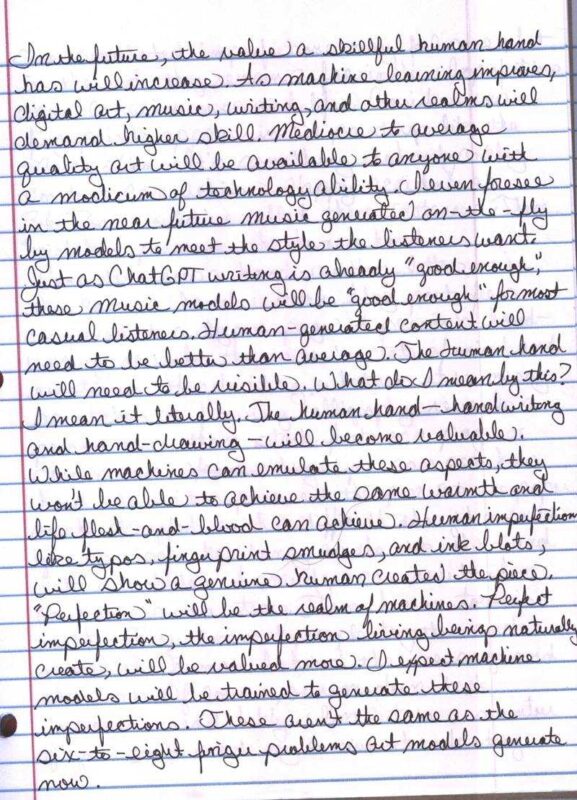
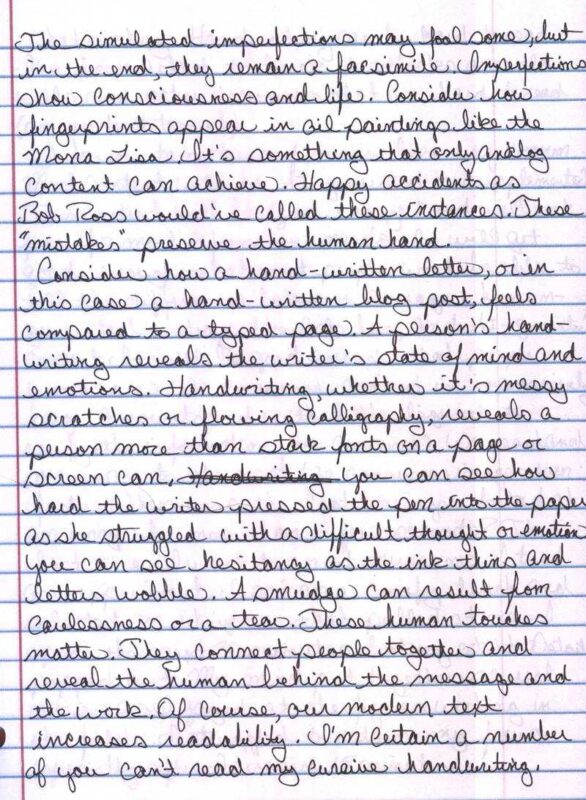
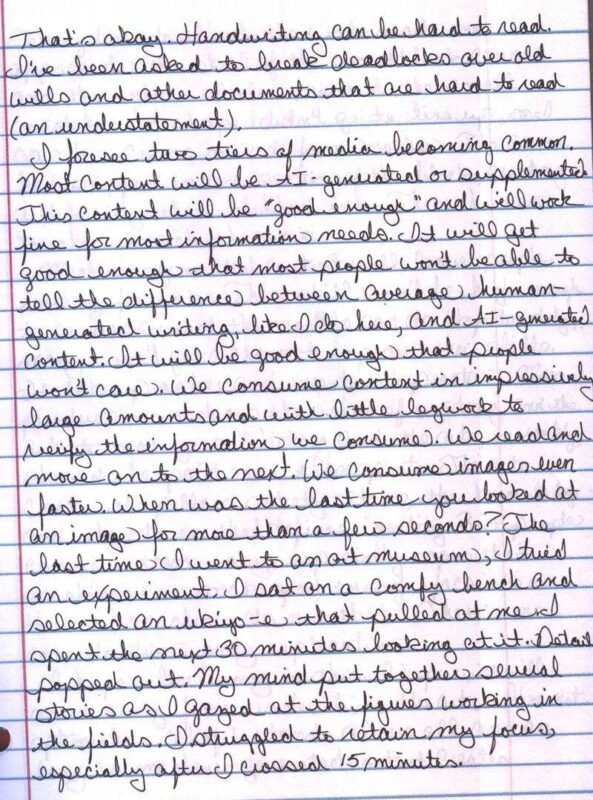
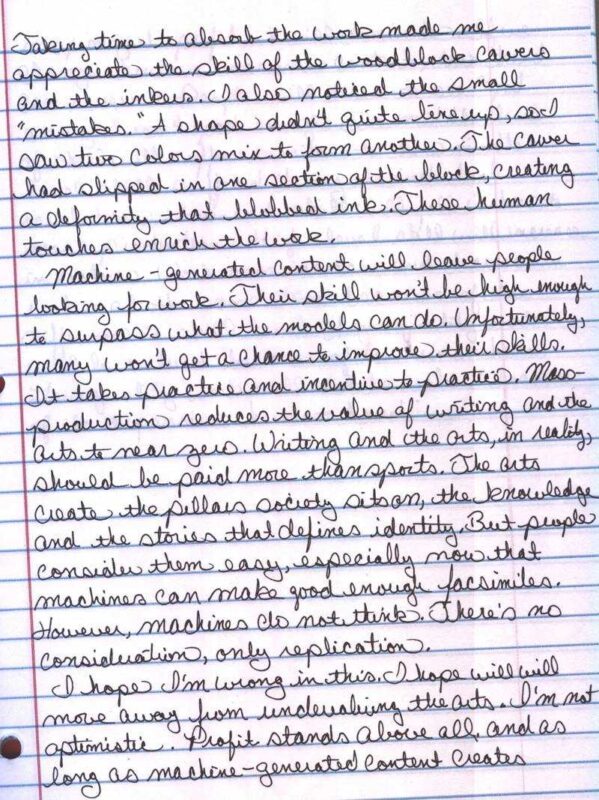
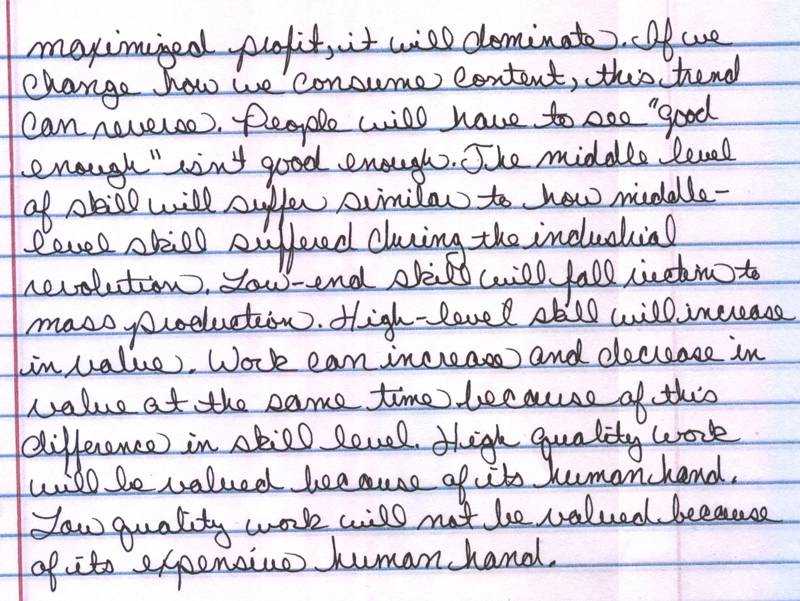
In the future, the value a skillful human hand has will increase. As machine learning improves, digital art, music, writing, and other realms will demand higher skill. Mediocre to average quality art will be available to anyone with a modicum of technology ability. I even foresee in the near future music generated on-the-fly by models to meet the style the listeners want. Just as ChatGPT writing is already “good enough” these music models will be “good enough” for most casual listeners. Human-generated content will need to be better than average. The human hand will need to be visible. What do I mean by this? I mean it literally. The human hand–handwriting and hand-drawing–will become valuable. While machines can emulate these aspects, they won’t be able to achieve the same warmth and life flesh-and-blood can achieve. Human imperfections like typos, fingerprint smudges, and ink blots, will show a genuine human created the piece. “Perfection” will be the realm of machines. Perfect imperfection, the imperfection living beings naturally create, will be valued more. I expect machine models will be trained to generate these imperfections. These aren’t the same as the six-to-eight finger problems art models generate now. The simulated imperfections may fool some, but in the end, they remain a facsimile. Imperfections show consciousness and life. Consider how fingerprints appear in oil paintings like the Mona Lisa. It’s something that only analog content can achieve. Happy accidents as Bob Ross would’ve called these instances. These “mistakes” preserve the human hand.
Consider how a hand-written letter, or in this case a hand-written blog post, feels compared to a typed page. A person’s handwriting reveals the writer’s state of mind and emotions. Handwriting, whether it’s messy scratches or flowing calligraphy, reveals a person more than stark fonts on page or screen can. Handwriting contains vulnerability and intimacy. You can see how hard the writer pressed the pen into the paper as she struggled with a difficult thought or emotion. You can see hesitancy as the ink thins and letters wobble. A smudge can result from carelessness or a tear. These human touches matter. They connect people together and reveal the human behind the message and the work. Of course, our modern text increases readability. I’m certain a number of you can’t read my cursive handwriting. That’s okay. Handwriting can be hard to read. I’ve been asked to break deadlocks over old wills and other documents that are hard to read (an understatement).
I foresee two tiers of media becoming common. Most content will be AI generated or supplemented. This content will be “good enough” and will work fine for most information needs. It will get good enough that most people won’t be able to tell the difference between average human-generated writing, like I do here, and AI-generated content. It will be good enough that people won’t care. We consume content in impressively large amounts and with little legwork to verify the information we consume. We read and move on to the next. We consume images even faster. When was the last time you looked at an image for more than a few seconds? The last time I went to an art museum, I tried an experiment. I sat on a comfy bench and selected an ukiyo-e that pulled at me. I spent the next 30 minutes looking at it. Details popped out. My mind put together several stories as I gazed at the figures working in the fields. I struggled to retain my focus, especially after I crossed 15 minutes. Taking time to absorb the work made me appreciate the skill of the woodblock carvers and the inkers. I also noticed the small “mistakes.” A shape didn’t quite line up, so I saw two colors mix to form another. The carver had slipped in one section of the block, creating a deformity that blobbed ink. These human touches enrich the work.
Machine-generated content will leave people looking for work. Their skill won’t be high enough to surpass what the models can do. Unfortunately, many won’t get a chance to improve their skills. It takes practice and incentive to practice. Mass production reduces the value of writing and the arts to near zero.Writing and the other arts, in reality, should be paid more than sports. The arts create the pillars society sits on, the knowledge and the stories that defines identity. But people consider them easy, especially now that machines can make good enough facsimiles. However, machines do not think. There’s no consideration, only replication.
I hope I’m wrong in this. I hope we will move away from undervaluing the arts. I’m not optimistic. Profit stands above all, and as long as machine-generated content creates maximized profit, it will dominate. If we change how we consume content, this trend can reverse. People will have to see “good enough” isn’t good enough. The middle level of skill will suffer similar to how middle-level skill suffered during the industrial revolution. Low-end skill will fall victim to mass production. High-level skill will increase in value. Work can increase and decrease in value at the same time because of this difference in skill level. High quality work will be valued because of its human hand. Low quality work will not be valued because of its expensive human hand.
I left this essay garbled to show my messy human hand. While it appears contradictory, opposing realities coexist. The human hand can decrease in value and increase in value. We can devalue writing and elevate writing. We can value mass production and singular production. A rich mind holds opposing ideas and sees their connections.
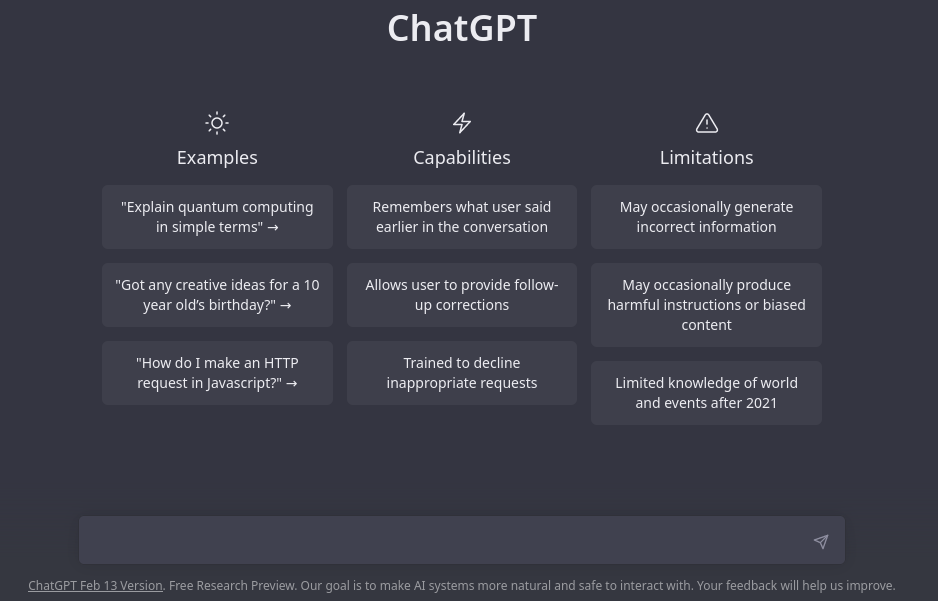
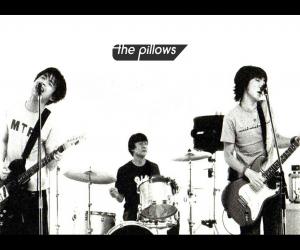


Supervising standardized academic testing this week. Knowledge and skills can be a challenge, more so for some than for others. Humans aren’t especially “standardized”. Regardless, we work to create consistent systems because they’re efficient… and cheap. We may loathe it, especially when it exposes our human limits. But it’s what allows for 8-billion humans… if not the industrial and intellectual torpor of at least some of them. At what point is inefficiency justified? At what point do we stop being humans?
Arbitrary educational standards are understandable, if wrongheaded. When I taught, I used a portfolio system, grading according to each student’s personal improvement rather than reaching some arbitrary standard. Granted, I wasn’t teaching in a formal school. A portfolio-grading system wouldn’t work because of the resources needed, even though it is the superior individually-cultivating system.
Humans vary a lot. Some are more communal; others are more solitary. Would forcing the communal to be solitary or the solitary to be communal (the more common situation) stop them from being human? Does it violate human dignity? Technology is also a part of being human. Humans make technology by nature. So perhaps we can view using and creating AI as a part of being human too? Resisting technology could be seen as a denial of human dignity in this case. It’s quite a tangle.
Standing on the shoulders of the great American mythology, the only practicable form of “equality” is a lowest common denominator. Meaningful self-improvement is certainly an individual prerogative. Regardless, I do think it’s a good idea to enforce some basic level of education in a functional democracy. But even that seems to a great deal to ask anymore.
You mentioned “Ghost in the Shell” in your latest post, which ironically hinged on the whole definition of what it is to be “human”. I’m certainly no Luddite. But I’ve always had a very visceral sense that any dependence upon technology weakens our connections. To paraphrase Philip K. Dick, the tyranny of technology is that it doesn’t know I exist. So what if a technology becomes sentient, whether independently, or through a human mind? Ultimately, it’s that human intent that makes the accidentally flawed woodblock (or intentionally flawed Navajo beadwork) special. It’s an interesting enough question to have elicited a post.
You’re right about the problem with “equality.” The equality of human dignity, sadly, doesn’t work in practice either with how human psychology works.
I’m a technologist, so I have a natural interest and attraction to technology. All animals have instincts that drive their behavior. Human instinct is to create technology. Technology doesn’t have to weaken our connections. Navajo beadwork is technology. Rather, how the profit and fame motives drive technology leads to technology weakening our connections. Broken people are more profitable than whole people. As you wrote, human intent behind the technology matters. While there’s nothing wrong with profit, maximizing profit at the expense of other people shows wrong intent.